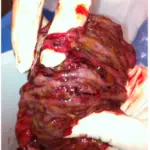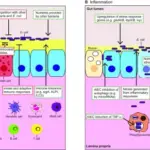Campylobacter enterocolitis is a common cause of intestinal infection. These bacteria are also one of the many causes of traveler’s diarrhea or food poisoning.
What is the Pathology of Campylobacter Enterocolitis?
The pathology of campylobacter enterocolitis is:
-Etiology: The cause of campylobacter enterocolitis is eating raw or undercooked poultry or eating something that touched it.
-Genes involved: None.
-Pathogenesis: The sequence of events that lead to campylobacter enterocolitis
-Histology: The histology associated with campylobacter enterocolitis shows campylobacter.
How does Campylobacter Enterocolitis Present?
Patients with disease in lower case typically all genders at any age. The symptoms, features, and clinical findings associated with campylobacter enterocolitis include bloody diarrhea, fever, and stomach cramps.
How is Campylobacter Enterocolitis Diagnosed?
Campylobacter enterocolitis is diagnosed by laboratory test detects Campylobacter bacteria in stool, body tissue, or fluids.
How is Campylobacter Enterocolitis Treated?
Campylobacter enterocolitis is treated by Azithromycin therapy.
What is the Prognosis of Campylobacter enterocolitis?
The prognosis of campylobacter enterocolitis is excellent. Most people recover from infection without antibiotic treatment.



